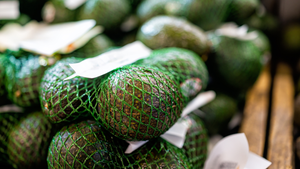Frozen food forteFrozen food forte
January 1, 2018
From appetizers to snack foods to entrees, the better-for-you frozen food category is heating up. By Carol Radice Time-pressed consumers are always looking for more convenient meal solutions and many are turning to frozen foods. However consumers are also looking to improve their diet and are not willing to give up their health—or quality—for convenience.When it comes to frozen foods, many industry observers say there is a growing demand for products featuring fresh, real ingredients, a “clean” label and low-calories that are quick and easy to prepare while providing a more nutritious profile. More and more, today’s mainstream consumer is also focusing on light and lean frozen options along with items that contain less sodium and fat and have higher protein and fiber. Retailers that want to capitalize on the growing trend should take a closer look at the natural channel, which industry observers say is often a precursor to mainstream sales. “Humane is the new organic and this trend will likely emerge as a significant purchasing factor within mainstream consumers in the near future,” says Matthew Gillespie, director of trade and sales planning for Carson, Calif.-based Cedarlane Natural Foods. Best known for its broad line of better-for-you frozen ethnic and American dishes, Gillespie says the company is in the process of rebranding its products to be more relevant to younger consumers. Other frozen food manufacturers are looking to attract a younger consumer as well. One sure way is with snack foods. “The types of products that are driving sales are the lighter, reinventions of frozen snack foods,” says Bob VonEschen, founder and CEO of Bolder Bob’s Foods. Working on the platform “good food that tastes good,” Bolder Bob’s, based in Boulder, Colo., has designed products with just that in mind. Sold under the Appetizer Adventures label, VonEschen says the pizza-inspired product can be eaten as a snack, light entrée or appetizer to share and comes in six flavors: A Taste of Athens, A Taste of Beijing, A Taste of Napa Valley, A Taste of Naples, A Taste of Santa Fe and A Taste of Tuscany. The products are all vegetarian with a calorie count range of 210 to 290 for a two-piece 4.5-ounce serving. “Growth in the category is coming from busy families who are seeking products they can blend with their busy lifestyles,” says VonEschen. “Our product serves an interestingly diverse market of children (with the pizza-flavors), teens, college students and families because it is easy to prepare, has a familiar format, and yet has unique flavors and fewer calories without giving up great taste.” Golden Platter Foods, based in Newark, N.J., recently launched a line of fully cooked gluten-free breaded chicken nuggets, tenders, and patties. Made from all-natural ingredients, the products are allergen-free and do not contain additives, hormones or preservatives. According to president Scott Bennett, consumers are paying more attention to nutritional profiles on products and are more closely scrutinizing what is in their food. “Increasingly people are making the correlation that they feel better when they eliminate certain ingredients from their diets, gluten being among them,” says Bennett. “With that in mind, we saw a need for a value-oriented gluten-free product that better met the needs of today’s health-conscious consumers.” With a background in culinary arts and a burgeoning entrepreneur spirit, Philip Anson wanted to know if there was a market for his homemade burritos outside of those he was selling directly to the rock climbing community in Colorado. While researching the opportunity he discovered a major gap in healthy frozen offerings. “This wasn’t a category people were excited to shop,” says Anson, founder and CEO of Evol Foods, based in Boulder, Colo. “Freezing is a great way to preserve the quality and healthfulness of foods, but the category had been highjacked by low-cost producers turning out unhealthy choices that taste like cardboard.” Anson set out to produce a line of foods that would bridge the gap between restaurant quality trends and the convenient meal format of frozen that busy lives resonate with. His line quickly expanded from burritos to include rice and enchilada bowls, artisan flatbreads and pizza. The ingredient list for Evol Foods includes humanely and sustainably raised meats and proteins, no GMOs, no growth hormones, fresh produce, and traditionally made tortillas. In 10 years, the company has achieved distribution in 25% to 30% of grocery stores nationally. “For all the reasons movements such as farm to table and farmer’s markets are popular today with consumers, people are connecting with our brand too,” says Anson. Kid tested Tired of only seeing what he calls “highly processed junk food options” for kids in the frozen case, Matt Cohen, founder and CEO of Kidfresh, based in New York, decided it was time for a change. With the help of a top chef and a pediatric nutritionist, Cohen started with a concept store in New York that offered natural and organic kids foods, including their own, freshly prepared in their kitchen. Based on that success he decided to broaden their reach and offer their all-natural kids meals in supermarkets throughout the country. Describing the Kidfresh frozen meals as a twist on children’s favorite foods, the meals typically contain up to 33% of a child’s daily vegetable needs without anything artificial. Aimed at two- to nine-year-olds, the six varieties include Totally Twisted Pasta Meatballs, Rainbow Rice Chicken, Cheesy Ravioli, Spaghetti Loops Bolognese, Muy Cheesy Quesadillas and Wagon Wheels Mac & Cheese, each of which contain blended veggies including, tomatoes, sweet potatoes, carrots, butternut squash and more. Cohen says it has been a challenge to get retailers to see the opportunity, even when the Kidfresh corporate message spoke out against childhood obesity. “Based on the amount of cheap, processed, artificial and unhealthy products aimed at kids, consumers were clamoring for healthier alternatives,” he says. “Thanks to their pressuring retailers we have been given the opportunity to show some of the largest grocers what our products are about.” Ian’s Natural Foods, maker of a broad line of products with both kid and family appeal, recently launched a series of larger-sized products. “The reality today is that consumers want a healthy product, but there is also a limit to what they want to spend,” says Dena Zigun, director of marketing for the Lawrence, Mass.-based company. “Consumers love the ability to buy larger volume sizes especially when it represents a savings.” In addition to Ian’s allergy-friendly Chicken Nuggets and Alphatots potato fries the company now offers its fish sticks in a family pack size. The fish sticks recently became MSC-certified, something Zigun says was done to give consumers the confidence the fish was sustainably sourced. Ian’s is also launching Space Nuggets and allergy-friendly sweet potato fries without added sugar this month. Based on its allergy-friendly chicken nugget recipe, Space Nuggets features space-inspired shaped chicken such as lightning bolts, rocket ships, airplanes and planets. “As noted in a study published in the Journal of Pediatrics, food allergies are on the rise with some 8% of U.S. children having food allergies,” says Zigun. “However, just because people have food allergies it doesn’t mean they don’t also want tastier, healthier options.” Looking to offer sustainable alternatives to farm-raised seafood and dwindling seafood sources from the ocean, Eugene Wang took his family’s 20 years-plus experience in creating vegetarian foods and developed Sophie’s Kitchen—vegan seafood products that feature traditional, plant-based ancient superfoods such as konjac, a Southeast Asian staple naturally low in calories and high in fiber. Wang says the products are ideal for vegans, vegetarians and those with allergies to seafood. The Sebastopol, Calif.-based company’s lineup includes: Vegan Shrimp, Vegan Prawns, Breaded Vegan Shrimp, Breaded Vegan Calamari and Breaded Vegan Fish Fillets. “We designed the line to appeal to a wide range of people, not just those who are vegan or have allergies,” says Wang, who serves as the company’s managing partner. “We wanted to offer something the whole family could enjoy without worrying about where the seafood came from or if it was high in cholesterol.” By the end of the year Sophie’s Kitchen will be adding two new products—Breaded Vegan Scallops and Vegan Crab Cakes. Wang also notes the entire line will soon be gluten-free and Non-GMO. Retailers have been very receptive to Sophie’s Kitchen products and often comment about the line’s unique positioning, says Wang. What’s more, thanks to the company’s social media outreach Wang and his staff can easily demonstrate to retailers that they already have a built-in audience. “As we have learned via the blogs we are involved with and other social media outlets, consumers have been asking for vegan frozen alternatives for years,” he says. “Space is clearly an issue in the frozen case, but buyers are finding room for at minimum one or two of our SKUs.” Feeling out of place With the influx of better-for-you frozen foods, shelf placement has become a real challenge, say some manufacturers. While some retailers locate better-for-you frozen foods in the natural department, others are looking to incorporate them within the traditional frozen food aisle. The jury is still out with suppliers as to which location they prefer to be placed in but one thing they all agree on is the need to highlight the space so that consumers can find their products. Kidfresh’s Cohen’s preference is to be placed in the mainstream aisle, noting many grocers are getting away from having separate freezers in the natural set. In fact, he will even turn down retailers who insist on putting his products in a natural store-within-a-store setting. “That is simply not our positioning,” he says. “We are a mainstream, conventional brand and as such belong in the mainstream aisle.” Golden Platter Foods’ Bennett says that the time to review the frozen food category is long over due. He adds that retailers willing to invest in making a difference in the frozen food section will position themselves ahead of the pack. Also wanting to be viewed as a mainstream product that just happens to be gluten-free, Bennett says placing Golden Platter Foods’ items near conventional counterparts makes the most sense. “Retailers can best service their customers when they display new products alongside existing ones rather than tucking them away somewhere,” he says. “That sends a message that the product is not important. There’s no denying refrigeration cases limit creativity, but that’s not to say more effort shouldn’t be paid to maximizing that space.” As a newcomer, VonEschen is finding that the best way to help retailers build sales in the category is to first be a star in their own backyard and then expand from that point of strength. “Retail response has been positive with most telling us they’ve never seen anything like it but at the same time, some of these same retailers are already over SKUed in the appetizer arena so it takes a bit of tenacity and sampling on our part to convince them to consider our line,” he says. Calling category management “extremely challenging” in the frozen food category, given that some larger grocers organize their frozen department by eating occasion, Gillespie says he is fine with Cedarlane’s products being displayed alongside conventional offerings. “People are looking for frozen breakfast options, for example, and are often excited to find out there are healthier alternatives for them which is why integrating our products with conventional ones makes the most sense because that is how the mainstream consumer thinks and shops,” he says. “Retailers need to move beyond price and focus on offering products that are unique—point of difference sells products—a strategy some retailers have yet to apply to the frozen food category.”
About the Author
You May Also Like




